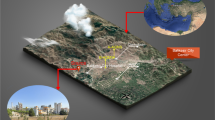Abstract
The goal of this paper is to compare and evaluate the performance of three air quality regulatory models for mercury releases. The models include Industrial Source Complex Short Term model (ISCST2), Industrial Source Complex Long Term model (ISCLT2), and SCREEN2. The evaluation is conducted in multiple point source urban environment using meteorological data, emission inventory and monitoring data for eight stations for the year 1990 to 1992. The performance of the models is evaluated using eight statistical parameters. The comparison of models results for both quarterly and annual averaging periods shows that ISCST2 predictions qualitatively match the observed concentrations; whereas SCREEN2 predicts highest concentrations and ISCLT2 the lowest concentrations. The summary of statistical analysis obtained by using three different methods of observed concentration (Co) and predicted concentrations (Cp) comparison show that the ISCST2 has a better overall performance than ISCLT2 and SCREEN2 models. However, none of the models met the criteria for a reasonable model. Summaries of 95% confidence limits on normalize mean square error (NMSE), geometric mean variance (VG) and geometric mean bias (MG) for each and among model indicate that of the three models, ISCST2 has the best overall performance indicators. Improved model performance may be achieved by incorporating different types of mercury forms into emission rate and air dispersion calculations.
Similar content being viewed by others
References
Brosset, C.: 1987, ‘The Behavior of Mercury in Physical Environment’, Water, Air, and Soil Pollut. 34, 145–146.
Environmental Protection Agency: 1984, Interim Procedures for Evaluating Air Quality Models (Revised), EPA-450/4-84-023, USEPA, RTP, NC.
Environmental Protection Agency: 1986, Guideline on Air Quality Model (Revised), EPA-450/2-78-027R, USEPA, RTP, NC.
Environmental Protection Agency: 1992, User's Guide for the Industrial Source Complex (ISC2) Dispersion Models, Volume I - User Instructions (1992), II - Description of Model Algorithms, and III - Guide to Programmers, EPA-450/4-92-008a, 008b, and 008c, USEPA, RTP, NC.
Environmental Protection Agency: 1992, SCREEN2 Model User's Guide, EPA-450/4Q-92-006, USEPA, RTP, NC.
Environmental Protection Agency: 1992, Protocol for Determining the Best Performance Model, EPA-454/4-92-025, USEPA, RTP, NC.
Environmental Protection Agency: 1993, Supplement B to the Guideline on Air Quality Models (Revised), EPA-450/2-78-027R-B, USEPA, RTP, NC.
Fischer, L. J.: 1993, Mercury in Michigan's Environment: Environmental and Human Health Concerns (A Science Report to Governor John Engler), Michigan Environmental Science Board, Lansing, MI.
Godbole, V. and Naperkoski, G. J.: 1984, An Operational Evaluation of the Industrial Source Complex Model, Conference on Applications of Air Pollution Meteorology, American Meteorology Society, 70–75.
Hanna, S. R., Strimaitis, D. G. and Chang, J. C.: 1991, Hazard Response Modeling Uncertainty (A Quantitative Method), Volume I, II, and III, Sigma Research Corporation, Westford, MA.
Iverfeldt, A.: 1991, ‘Occurrence and Turnover of Atmospheric Mercury Over the Nordic Countries’, Water, Air, and Soil Pollut. 56, 151–165.
Kumar A., Leo, J. and Bennett, G. F.: 1993, ‘Statistical Evaluation of Lower Flammability Distance (LFD) using Four Hazardous Release Models’, Process Safety Progress (AIChE) 12(1), 1–11.
Kumar, A. and Mohan, S.: 1991, ‘Use of Bulletin Board Systems For Air Quality Management’, Environmental Progress (AIChE) 10(1), F1–F11.
Kumar, A. and Ranganathan, M.: 1993, ‘Software for Preparing Meteorological Data for Industrial Source Complex Models’, Environmental Progress 12(4), N9–N17.
Patel, V.: 1995, Application, Comparison, and Evaluation of Three Air Dispersion Models: ISCST2, ISCLT2, and SCREEN2 for Mercury Emissions, Master Thesis, The University of Toledo, Toledo, OH.
Peterson, G., Iverfeldt, A. and Munthe, J.: 1995, Atmospheric Mercury Species Over Central and Norhtern Europe, Model Calculations and Comparison with Observations from the Nordic Air and Precipitation Network for 1987 and 1988, Atmospheric Environment 29(1), 47–67.
Riswadkar, R. M. and Kumar, A.: 1994, ‘Evaluation of the Industrial Source Complex Short-Term Model in a Large-Scale Multiple Source Region for Different Stability Classes’, Environmental Monitoring and Assessment 33, 19–32.
Schroeder, W. H. and Jackson, R. A.: 1987, ‘Environmental Measurements with an Atmospheric Mercury Monitor having Speciation Capabilities’, Chemosphere 16, 183–199.
Sills, R.: 1992, Environmental Mercury Concerns, Memorandum Distributed to Interested Parties on June, 1992, Michigan Department of Natural Resources, Great Lakes and Environmental Assessment Section, Lansing, MI.
Author information
Authors and Affiliations
Rights and permissions
About this article
Cite this article
Patel, V.C., Kumar, A. Evaluation of Three Air Dispersion Models: ISCST2, ISCLT2, and Screen2 for Mercury Emissions in an Urban Area. Environ Monit Assess 53, 259–277 (1998). https://doi.org/10.1023/A:1005810619145
Issue Date:
DOI: https://doi.org/10.1023/A:1005810619145




